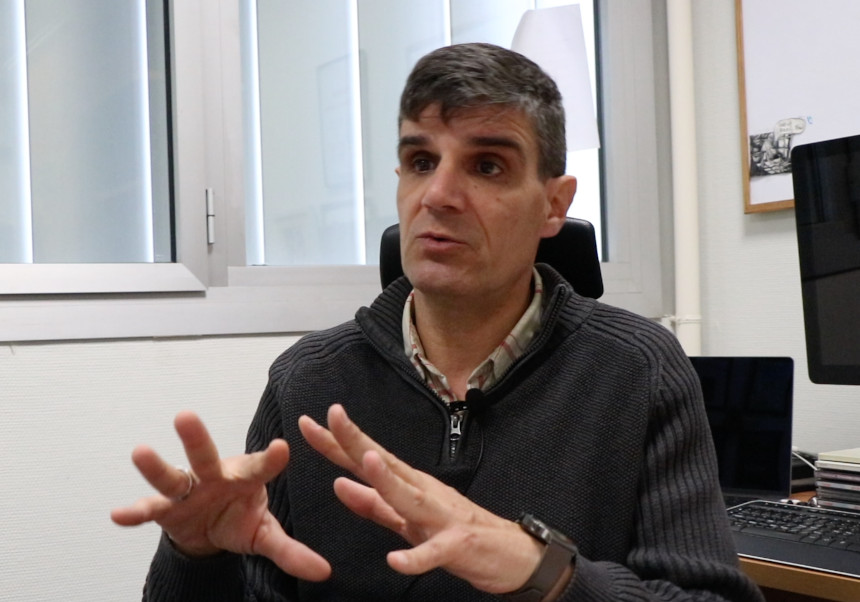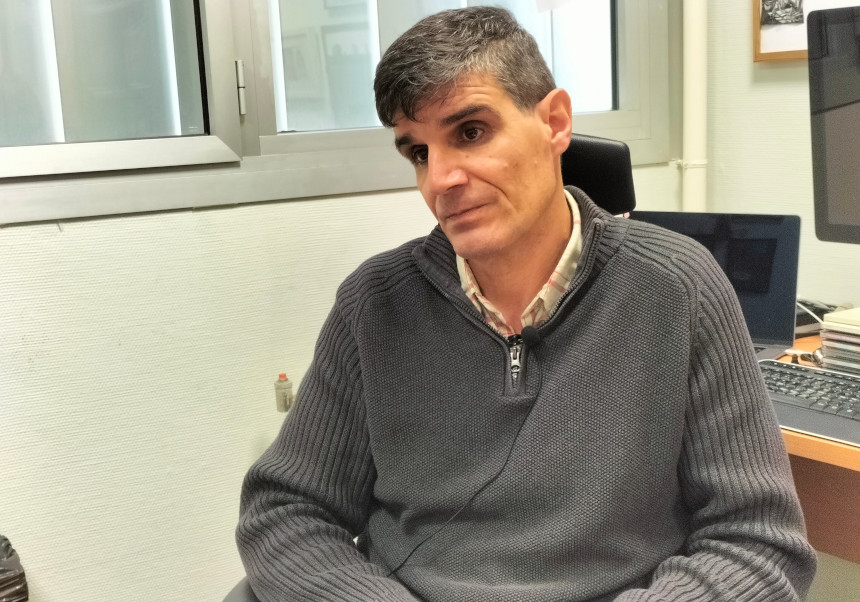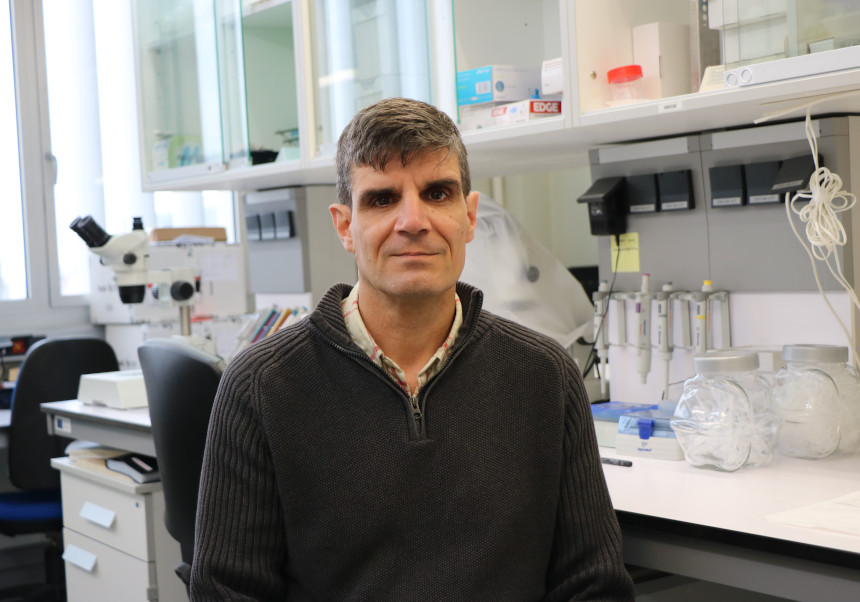Juan Nácher: “It has been proved that cannabis is a risk factor for the development of schizophrenia”
- Scientific Culture and Innovation Unit
- March 29th, 2023
Juan Nácher Roselló, full professor of Cellular Biology at the University of Valencia (UV), is one of the main researchers of the Spanish Network for Cooperative Study in Mental Health (CIBERSAM), as well as a researcher at the University Institute of Biotechnology and Biomedicine (BIOTECMED) of the academic institution. Since COVID-19, mental illnesses have increased exponentially. In this interview, the expert deals with these disorders from a biological perspective and explains their relationship with neuronal plasticity and inhibitory neurons.
As a Neurobiology researcher, could you tell us what his main line of research is and what other topics have been carried out in your study?
Regarding our line of research, we are especially interested in psychiatric diseases. We approach them from different angles, both from the study of humans and animal models. On the one hand, we are very interested in seeing how adverse experiences affect early life. On the other hand, we are interested in seeing how inhibitory neurons and their plasticity are altered during these experiences and in mental illnesses. We also have lines of research on possible therapies for some of these disorders, such as treatment with erythropoietin (EPO). And finally we have a more clinical line dedicated to observing alterations in functional and structural neuroimaging of psychiatric patients.
Your research team focuses its work on schizophrenia or depression. Why?
The interest of our research comes because schizophrenia or depression are very prevalent diseases in society, that is, they have a very important impact in terms of the number of patients, as well as being very serious diseases, not only for the people who suffer from them, but for the entire environment. Therefore, it is vital to know more about the bases of these diseases and how to treat them.
"Schizophrenia or depression are very prevalent diseases in society"
Why are there people who have a greater genetic predisposition to suffer from this type of disorder?
These mental disorders are polygenic or multifactorial, that is, there is no specific genetic load, they are not caused by a single gene, but by an alteration in different genes. There is not a very clear inheritance, since there is no gene for schizophrenia or depression, rather it is the different combination of different genes that contributes to the development of these diseases. In addition, there is also a part of the environment that influences, such as relationships during neurodevelopment, infections during pregnancy, abuse, etc.
Would it be possible to recognise the genes that are involved in this predisposition?
What can be detected are alterations in genes that are more frequent in people who are sick, but it cannot be determined from the gene load if a person is going to be sick. There are still no genetic markers that allow us to do predictive and accurate analyses.
It is said that schizophrenic patients have a common denominator and that is that they have used cannabis. Is it a decisive factor?
Cannabis use is a risk factor in adolescence for the development of schizophrenia, especially when very high doses are consumed or when cannabis is consumed with high psychoactive substances. This does not mean that if you consume cannabis during adolescence, you will have a psychotic episode during adulthood, but it does mean that it has been proven that there is something particular about this plant that makes it a risk factor.
"The functional neuroimaging clinical technique is a series of magnetic resonance-based procedures used to view the brain of living patients. Both changes in the structure and in the functioning of certain regions can be observed"
Erythropoietin (EPO) treatment, what is it and why have you and your team been so interested in it?
It is a very interesting hormone since it has been seen to have important effects on the formation of blood cells and on the central nervous system (CNS), as well as stimulating the plasticity of neurons. We have been working with animal models to understand what this hormone produces in the brain, and, in collaboration with other researchers, it is shown that it is capable of causing new synapses, that is, new neuronal connections. It also affects glial cells (what are they). In short, it is a molecule that has great potential for the treatment of psychiatric illnesses, especially depression.
In their research they use the clinical technique of functional and structural neuroimaging. What does it consist of?
The functional neuroimaging clinical technique is a series of magnetic resonance-based procedures used to view the brain of living patients. Both changes in the structure and in the functioning of certain regions can be observed. These are techniques that still have a low resolution compared to postmortem techniques or in animal models, but that give a lot of information because you are seeing the patient as he is. What we do is go from the animal model to the human and from the human to the animal model, trying to find ways of connecting.
What do we understand by neuronal plasticity and what relationship do they have with psychiatric diseases?
It is the ability of neurons to modify their connections in response to changes in the environment. We live in a very changing environment, in which we need to learn, build memory, etc. and, to do that, what neurons do is either modify the efficiency of their synaptic connections, or create or destroy synapses to accommodate themselves, as the environment changes. Thus, this capacity is basic for the functioning of our brain, which, if altered, could trigger changes in behavior that, if they go further, could be considered pathological.
What have been the main contributions of neurobiology on neuronal plasticity?
Neurobiology has come a long way in recent years. We now know how neurons can change, and not only during early life, but also during adult life. In this way, we understand much better which molecules are involved in the loss of effectiveness in a synapse, how neurons can change their structure to create new synapses or which molecules are involved in the restructuring of said neurons, among other issues.
Neuroplasticity occurs mostly in the early stages of life. Is it true that it increases our learning capacity? How to stimulate it in more adult ages?
When our nervous system develops, there are some “windows” where the brain is especially plastic and it is reasonable that this is the case, since in those early phases we are finishing sculpting the structure of our nervous system. Once the end of these “windows” of time in childhood and adolescence approaches, the system loses plasticity and its structure settles down. This does not mean that there is not a certain level of plasticity in adult life, because if not, we could not learn or modify behavior, but it is true that it never becomes as plastic.
Today we know that those critical periods can be reopened in many ways. For example, modifying certain molecules, stimulating the nervous system with exercise, with drugs such as antidepressants, which produce an increase in said plasticity. And this is important, because if we are able to stimulate neural plasticity and combine it with some therapies, such as psychological ones, this can help modify the brain and bring us closer to a cure for nervous system pathologies.
"If we are able to stimulate neural plasticity and combine it with some therapies, such as psychological ones, this can help modify the brain and bring us closer to a cure for nervous system pathologies"
In the future, what advances are expected to be obtained in the field of neuronal plasticity?
They have to start developing molecules that are capable of inducing this plasticity in a more stable and controlled way. In addition, the objective is to be able to direct this plasticity to certain regions of the nervous system, that is, that it is not something global, but that we can redirect it to specific nerve centers. For example, in some pathology that involves the amygdala, we should be able to increase plasticity in that specific region. On the other hand, the new advances should not be based only on drugs, but should consider other areas of action, such as magnetic stimulation, which, through magnetic waves, can reach certain particular neurons and promote their plasticity. Very interesting results are being found with this type of technology.
What does neurobiology say about adverse experiences in childhood or adolescence?
Adverse experiences early in life can change the structure of the brain and how neurons work, and this is very important because it can cause alterations not only in neurons per se, but also in the constructions of neural circuits, so in the end you can end up with a circuit that is messed up because it hasn’t been built correctly.
You have also studied the role of inhibitory neurons in their relationship with psychiatric illnesses. What are they and why are they important?
Much of our research is focused on inhibitory neurons. The nervous system works mainly through excitatory neurons, which constitute the basic neural circuits, but, in addition, our brain has an “extra” complex system and that is that it has neurons that serve to regulate these excitatory neurons, the so-called inhibitory neurons. These do two important things, prevent there from being an overexcitation of the circuits and synchronise them, that is, the inhibitory neurons help the excitatory neurons to activate synchronously, and this generates rhythms that are very important for our learning and our memory. They are also known to be altered in many psychiatric illnesses, such as depression and schizophrenia.
"Adverse experiences early in life can change the structure of the brain and how neurons work, and this is very important because it can cause alterations not only in neurons per se, but also in the constructions of neural circuits"
-------------------------
"In general, in Spain there is a deficit in mental health care and there is not the investment that there should be, nor are there enough professionals in charge of patients, neither psychiatrists nor psychologists"
Given the special public interest in mental health. Do you think that there is enough public and private support for research on these psychiatric illnesses in Spain? And support for research in neurobiology? What is the situation at European level?
No. In general, in Spain there is a deficit in mental health care and there is not the investment that there should be, nor are there enough professionals in charge of patients, neither psychiatrists nor psychologists. There is also not enough investment in research, but there is not in general, not only in the field of mental health. At a European level it depends on which countries, the richest and most sensitive to the matter, invest the most, as in Sweden. Then there are others who are even worse. In summary, without a doubt, a greater effort must be made to invest in research.
You are a professor of Cellular Biology specialising in neurobiology. Do you perceive that there are more scientific vocations in your area of knowledge in recent years? Why?
Not more nor less. In fact, students are increasingly aware of how difficult it is to pursue a career in science, since it is very poorly paid and has a very high level of precariousness until you are of considerable age.
There are many great scientists who have searched for the meaning of life outside of science. Do you think neuroscience can answer questions about what our nature is, why we seek meaning in life, or whether we are special beings among animals?
I do think you can answer many of those things. But basically I think because the mind is a construct of the brain. Let’s say that it is the brain itself that generates our sensation of awareness and perception of what we are. Our consciousness and self-perception as beings and of our destiny in life are all mechanisms that the brain has, or consequences of the brain’s own construction. When you have generated a machine as complex as the brain, it is normal or inevitable that this type of mental construction appears.
What does neuroscience think about meditation? Does it really produce changes in the frontal cortex as various studies say?
There are many studies, especially functional resonance, on how brain activity is modified in meditation. Personally, I have personal experience with mindfulness, which is a type of guided meditation, and it does seem to have a significant effect on stress and relaxation.
These activities, Stimulating scientific vocations, are part of the scientific dissemination activities plan of the Scientific Culture and Innovation Unit. They are co-funded by the Ministry of Science and Innovation and the Spanish Foundation for Science and Technology, in addition to having the support of MEDNIGHT GTS, a project associated with the initiative “European researchers’ Night” of the European Union, which has the funding of Marie Skłodowska-Curie actions and call identifier: HORIZON-MSCA-2022-CITIZENS-01 (MSCA and Citizens 2022).



















